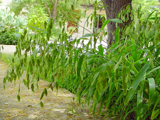Native Plants

Q. Who is Mr. Smarty Plants?
A: There are those who suspect Wildflower Center volunteers are the culpable and capable culprits. Yet, others think staff members play some, albeit small, role. You can torture us with your plant questions, but we will never reveal the Green Guru's secret identity.
Did you know you can access the Native Plant Information Network with your web-enabled smartphone?
Ask Mr. Smarty Plants is a free service provided by the staff and volunteers at the Lady Bird Johnson Wildflower Center.

rate this answer
Saturday - August 09, 2008
From: Houston, TX
Region: Southwest
Topic: Erosion Control
Title: Erosion control for slope to detention pond
Answered by: Nan Hampton
QUESTION:
We have been required by code to build a detention pond for new church buildings in the Webster, TX (Clear Lake) area. There is a serious erosion of soil from water runoff from the building roof needing immediate attention to stabilize the slope, then plant native turf grasses. The distance between the building and the pond rim is about 14' maximum. Seeking advice on erosion control matting and choice of seed or sod grasses.ANSWER:
Here is information about using erosion-control blankets and/or fiber or coir rolls to stabilize the erosion area. The fiber rolls and erosion-control fabric work by slowing the runoff water and allowing sediment to fall out rather than be washed away. Seeds are sown under the erosion-control material and grow up through the matting when they germinate. Underneath the matting the roots of the plants growing through the erosion-control material anchor the soil to stop the erosion. If you use erosion-control blankets made of biodegrable material, they will eventually disappear leaving the plants to control the problem.
Native grasses are an excellent choice for controlling erosion because they develop extensive fibrous root systems that hold the soil in place. Seeds can be sown under an erosion control blanket or grass plugs can be planted through the blanket. After the grasses have begun to establish themselves and stabilize the area you can add other plants. On the pond edge you could consider adding some attractive aquatic plants to help with the erosion.
Native American Seed in Junction, Texas has a turf grass mix that is 34% Bouteloua gracilis (blue grama) and 66% Bouteloua dactyloides (buffalograss). This grass mixture requires little or no mowing (maximum height is 5 to 8 inches) and will not require extra watering once established. It does best in full sun but will tolerate some shade.
Another possibility for a native turf grass is Muhlenbergia schreberi (nimblewill). It is a fine feathery grass that looks similar to bermuda grass. Please see the answer to a previous question discussing nimblewill.
Here are a few plants that would do well around the detention pond:
Chasmanthium latifolium (Inland sea oats)
Andropogon glomeratus (bushy bluestem)
Lobelia cardinalis (cardinalflower)
From the Image Gallery
More Erosion Control Questions
Deer Resistance and Erosion Control for St. Louis County MO
January 03, 2014 - I am looking for deer and rabbit resistant native plants for erosion control on a steep ravine slope with part sun and part shade in St. Louis County MO.
view the full question and answer
Will not cutting grass make its roots stronger?
May 27, 2009 - I live on a lake that has a hill. There is some problem with erosion on the hillside. Our association wants us to not cut the grass to stop the erosion. How does not cutting the grass help the roots g...
view the full question and answer
Groundcover for foot traffic in dry shade from Prineville OR
May 12, 2013 - I live in central Oregon. I have an area under a large elm tree that slopes on all sides and has lots of foot traffic and no sun. (my kids have a swing in the tree and play around it a lot.) It's a v...
view the full question and answer
Getting rid of non-native, invasive English Ivy from Davidsonville MD
March 19, 2014 - Just moved and need to rid the well established Ivy planted on the steep slope area around the back and side of the house as it is taking over the bushes on the top and trees in forested area at botto...
view the full question and answer
Retention ponds for states in southeast, from Greenville SC
July 14, 2012 - We provide maintenance for Stormwater detention ponds and are looking for native grasses to plant in the bottom and sides of typically dry detention basins. Prefer low growing grasses that spread to...
view the full question and answer
| Support the Wildflower Center by Donating Online or Becoming a Member today. |

